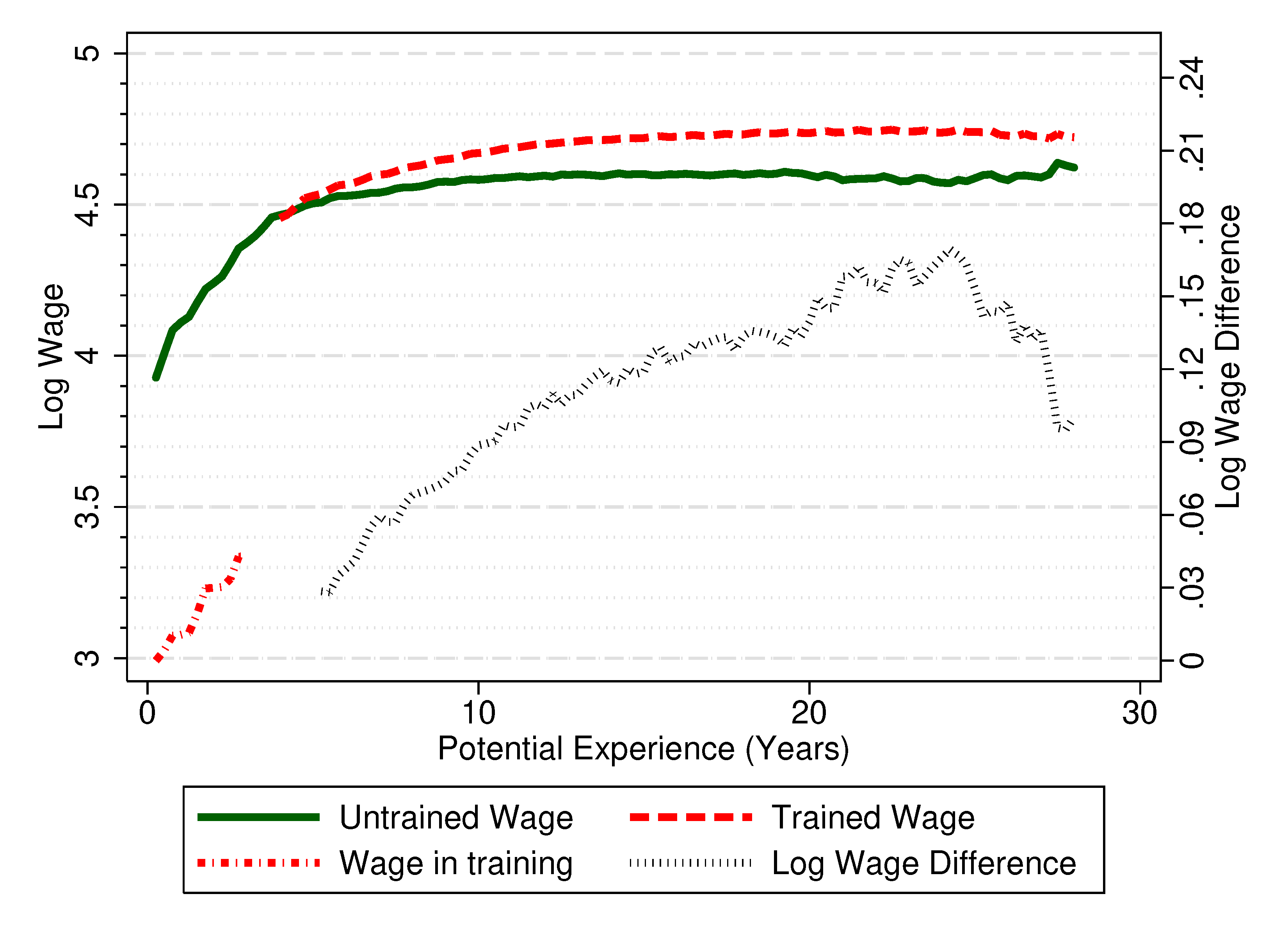How workers’ careers develop over their life cycle and how wage growth is affected by their early educational choices are key questions for economists and policymakers alike. They are also crucial for assessing earnings inequality (see Lucas et al. 2016), an economy’s overall productivity, and citizens’ ensuing wealth. Early works in economics emphasise the role of human capital (see e.g. Becker 1994, Mincer 1974, Ben-Porath 1967, Killingsworth 1982) as well as search capital and the mobility of workers across firms (see Topel and Ward 1992) as essential drivers of wage growth. More recent work (e.g. Autor et al. 2003) highlights the selection of workers across sectors with different task requirements according to the workers’ innate abilities. Workers’ career choices may be affected not only by the income opportunities the jobs generate but also by non-pecuniary attributes of jobs, such as working conditions and commuting distances (e.g. Le Barbanchon et al. 2021).
Wage growth over the life cycle
In a new paper (Adda and Dustmann 2023), we develop a unifying framework that analyses these sources of wage growth over workers’ life cycles. We use longitudinal administrative data from Germany that follows workers for up to three decades. We focus on workers who first enrolled in apprenticeship training after secondary school and those whoe entered the labour market directly. In our framework, individuals choose between two types of jobs – jobs whose tasks are mainly manual and repetitive (routine-manual jobs) and those requiring more cognitive and abstract skills (cognitive-abstract jobs). In addition, monetary and non-monetary job characteristics, such as flexibility or location, drive individuals’ job choices.
Apprenticeship training
Figure 1 illustrates the wage growth of workers who undertook an apprenticeship before entering the labour market and those who directly entered the labour market without further training. During the training period, the wages of apprentices are low, as they partly pay for their training through reduced remuneration (see Dustmann and Schoenberg 2012). After the training period, wages increase sharply and continue to rise slowly over the next two decades. In contrast, the wages of those who enter the labour market directly after secondary school increase rapidly during the first five years in the labour market, by 11% per year on average. Over the next 20 years, real wage growth is just 0.4% per year. Twenty years after graduating from secondary school, the wages of workers who went through apprenticeship training are about 15% higher than those of the untrained.
Figure 1 Wage growth of workers by training status
Notes: Potential experience is counted from entry into the labour market for untrained workers and from the start of training for trained workers. See Adda and Dustmann (2023) Sections 2.3 and A for further details.
Data source: IAB Social Security data, 1975–2004.
Figure 1 hides essential aspects of career advancement that result from apprenticeship training and thus provides an incomplete picture of the merits of apprenticeship training and where such benefits are felt.
Our estimated model allows for a causal assessment of the various channels that benefit workers who choose apprenticeship training, while addressing the potential self-selection of workers into such schemes. We show that apprenticeship training allows workers to access better jobs with more growth potential later in their careers, thus sustaining wage growth later in the lifecycle; it leads to more labour market attachment early on in careers, thus allowing faster accumulation of work experience; and it sharply reduces the likelihood of unemployment and eases the transition back from unemployment into work.
Throughout the first two decades of a career, a higher fraction of those who went through apprenticeship training is in work, while workers who entered the labour market directly after secondary school have a higher risk of unemployment and a lower probability of returning to work from unemployment. Overall, this leads to untrained workers spending less time working: over 25 years, they work a total of 17.4 years, compared with 20.1 for workers who went through apprenticeship training.
In consequence, apprenticeship training provides substantial career advantages for workers, reflected in more persistent wage growth, access to better jobs later in a worker’s career that helps sustain wage growth later in the lifecycle, reduction in layoffs risk, and improved hiring prospects.
An assessment of vocational training schemes based on immediate returns alone is, therefore, inadequate – it is the subtler longer-term effects on career outcomes that bring gains. However, apprenticeship training may not be the best choice for all workers – workers sort into vocational training programmes according to their innate ability.
We also investigate the benefits to society of implementing apprenticeship schemes, as apprenticeship training is costly for both firms and taxpayers. Accounting for the cost of training and contrasting them with the benefits through improving workers’ career prospects and reducing the incidence of unemployment, we show that the overall rate of return from the societal point of view is about 10%. Thus, apprenticeship training provides significant returns to the individual and society (see Doepke et al. 2017 for an assessment from a historical perspective).
Why do wages grow?
Our analysis of workers’ wages over their life cycle shows that skill accumulation on the job is the most significant driver of early wage growth. Routine-manual skills contribute strongly to workers’ productivity and wage growth in the first years of their careers. In contrast, cognitive-abstract skills (which are accumulated faster when choosing apprenticeship training) have a longer-lasting impact, leading to sustained growth throughout the career.
A second essential factor for wage growth is job-to-job mobility, which explains roughly one-third of wage growth in the first five years of a worker’s career. Changing firms allows young workers to find jobs where they are most productive. As a result, switching between different jobs generates a significant increase in earnings, concentrated in the early years of the career.
Do workers change jobs only for monetary reasons?
Job-to-job mobility is driven primarily by income-maximising behaviour (i.e. choosing the job that pays the highest wages and offers the best career prospects). However, non-pecuniary attributes of jobs also matter – attributes such as working conditions, interaction with colleagues, or ease of commuting to the workplace. In the early years of a worker’s career, job amenities account for about a quarter of job-to-job transitions. Thus, non-pecuniary job amenities are a crucial determinant of workers’ choices.
What determines the type of jobs workers are choosing and what are ‘lock-ins’?
The workers’ choice between jobs that require predominantly routine-manual or cognitive-abstract skills depends on (unobserved) sector-specific ‘talent’ and (observed) past educational decisions. Moreover, it also depends on sector-specific skills that workers accumulate through working in different occupations. This can generate ‘lock-in’ effects: workers who initially join a sector for which they are less talented may then accumulate experience specific to that sector, which disincentivises moving to jobs in a sector for which the workers are more talented. For instance, a worker may become a car mechanic when entering the labour market because it was the only job available but their innate ability makes them better suited for an office job. The worker may not change sectors after some years because it generates substantial costs through the loss of accumulated sector-specific skills. Such occupational lock-in effects may be aggravated by recessions that restrict sector choices.
References
Adda, J, and C Dustmann (2023), “Sources of wage growth”, Journal of Political Economy 131(2).
Autor, D H, F Levy, and R J Murnane (2003), “The skill content of recent technological change: An empirical exploration”, Quarterly Journal of Economics 118(4): 1279–333.
Ben-Porath, Y (1967), “The production of human capital and the life cycle of earnings”, Journal of Political Economy 75(4, Part 1): 352–65.
Becker, G S (1994), Human capital (3rd ed.), Chicago: University of Chicago Press.
Doepke, M, J Mokyr, and D de la Croix (2017), “More than family matters: Apprenticeship and the rise of Europe”, VoxEU.org, 2 March.
Dustmann, C, and U Schoenberg (2012), “What makes firm-based vocational training schemes successful? The role of commitment”, American Economic Journal: Applied Economics 4(2): 36–61.
Killingsworth, M R (1982), “‘Learning by doing’ and ‘investment in training’: A synthesis of two ‘rival’ models of the life cycle”, Review of Economic Studies 49(2): 263–71.
Le Barbanchon, T, R Rathelot, and A Roulet (2021), “Gender differences in job search: Trading off commute against wage”, Quarterly Journal of Economics 136(1): 381–426.
Mincer, J A (1974), “The human capital earnings function”, in Schooling, Experience, and Earnings, NBER.
Lucas, R, E Rossi-Hansberg, and S Caicedo (2016), “Learning, career paths, and the distribution of wages”, VoxEU.org, 14 May.
Topel, R H, and M P Ward (1992), “Job mobility and the careers of young men”, Quarterly Journal of Economics 107(2): 439–79.



